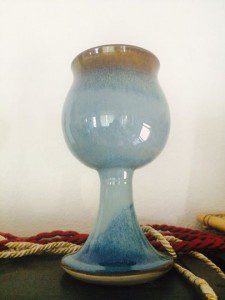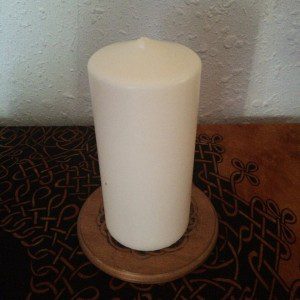I’ve presided over a lot of marriage ceremonies the last fifteen yeas. When I first started marrying folks there were very few resources out there for the aspiring Pagan clergy-person. Information tended to be either 100% Pagan or generic-Christian. That was a problem because in my experience most want something resembling a traditional ceremony, but with a small handfasting rite in the middle.
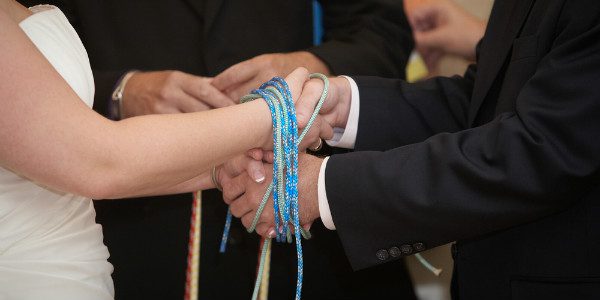
Since wedding ceremonies often involve all sorts of different people from various walks of life, many of the rituals involved in a wedding have very little explicit connection to a particular religious tradition. Most of the Pagan weddings I’ve been a part of have been more like “stealth Pagan weddings” than extensive affairs things resembling traditional Pagan/Wiccan ritual. (Sometimes you just don’t want to bother Grandma with something she might not understand.) There are often “Pagan parts” identifiable to those who know how to find such things, but generally invisible to everyone else.
Wedding ceremonies aren’t one seamless ritual, they are a combination of several smaller rites that create a greater whole. Society at large tends to fixate on the exchange of rings as the primary rite, but for many Pagans it’s the actual handfasting/tying the wrists together that’s most central. Candle lightings and chalice sharing rites also occur with some frequency, and can be great ways to make a wedding ceremony last a little bit longer.
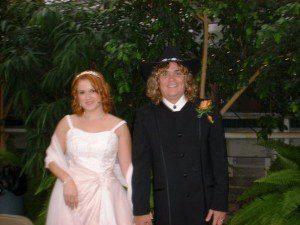 Weddings ceremonies can be exceedingly brief. I officiated my sister-in-law’s wedding a few weeks ago and after sending her my initial “standard wedding ceremony” script she replied with “that’s awfully short.” She was right, it was short, but since she didn’t want to talk there wasn’t a whole lot I could do to make it longer. I did eventually add some “Jesus stuff” that ended with me quoting Paul McCartney and John Lennon in addition to the Apostle Paul, but it was her wedding, no one was there to listen to me.* And weddings are always a little bit longer than most people anticipate because the simple act of a bride or groom walking down the aisle is a rite unto its self.
Weddings ceremonies can be exceedingly brief. I officiated my sister-in-law’s wedding a few weeks ago and after sending her my initial “standard wedding ceremony” script she replied with “that’s awfully short.” She was right, it was short, but since she didn’t want to talk there wasn’t a whole lot I could do to make it longer. I did eventually add some “Jesus stuff” that ended with me quoting Paul McCartney and John Lennon in addition to the Apostle Paul, but it was her wedding, no one was there to listen to me.* And weddings are always a little bit longer than most people anticipate because the simple act of a bride or groom walking down the aisle is a rite unto its self.
Instead of a putting a full ritual in this post, I’m going to share my ritual outline and then some of the “individual rites” that make up a wedding.
Procession(s) Family/Wedding Attendants/Couple
At my sister-in-laws wedding the highlight of the procession was her walking down the aisle arm in arm with her father. As they approached me, Dad gave his blessing to the groom by leaving his daughter when they reached her fiancee.
Officiant Greets those Gathered
Officiant welcomes everyone to the ceremony, if the officiant knows the couple this is sometimes a good opportunity for a joke. Breaking the tension can be really beneficial to the nervous couple.
God Stuff
I’ve done a lot of weddings with a Christian-slant. If I have to put some Bible stuff I usually do it here while ruminating on the meaning of love. It’s rather cliche but the best Christian-leaning love stuff comes from Paul (“love is patient, love is king”) and can be found in 1st Corinthians Chapter 13.
(Song?)
Sometimes people will put a song into the middle of their ceremony (that helps with length!). I tend to put it here because it’s a good transition spot.
Handfasting
Even when marrying Pagans the exchange of rings tends to take precedence over the handfasting rite. As a result I tend to it do before the Ring Exchange.
(Reading?)
Want a friend to read some poetry during the ceremony? Put it here. Can also be swapped with the song. Generally, most weddings I’ve done have been short on songs and poetry, but I’ve seen both in various weddings.
(Additional Activity)
If someone wants a chalice or candle rite it usually goes here, this can also be swapped with the handfasting rite above.
Exchange of Rings/Vows
“The exchange” (and it doesn’t necessarily have to be rings) remains the “big thing” in most weddings and is generally accompanied by vows. I have had some couples exchange vows during a chalice ceremony.
(Jumping the Broom)
Nothing feels more Witchy to me than jumping a broom, but this is not an ancient Pagan tradition. Slave couples in the American-South used to “jump the broom” to publicly proclaim their love and devotion to one another since they were not allowed to legally marry. The tradition persisted in African-American communities after the Civil War and is a part of many modern marriage celebrations. Since a lot Modern Witches today cherish their brooms this rite has become common-place in more witchy wedding ceremonies. I’ve never really “read” anything for a broom jumping, it’s just something jumped over as the couple walks back down the aisle at the end of the wedding. In such instance two of the attendants place the broom on the ground to be jumped or stepped over. The broom can be left on an altar or carried down the aisle by an attendant.
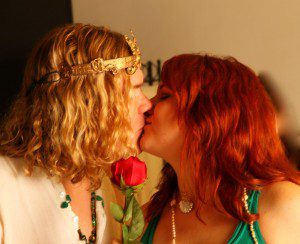 Handfasting Rite
Handfasting Rite
Officiant: “Today we will be performing a handfasting. For those of you who don’t know, a handfasting is a marriage rite that began in the Middle Ages. At that time when peasants got married they usually were unable to afford a clergyman to hear their vows or diamond rings to signify their love, so they began the ritual of handfasting.”
“In a handfasting a cord is wrapped around the wrists of the two people exchanging vows. Long ago this was tangible, physical proof that two people were married. They didn’t have licenses, pictures, or cellphone vidoes, but they could keep a cord as reminder of their love and commitment. Back in those days the cord was left wrapped around the happy couple’s wrists until the union was . . .uhmm . . consummated. I think the reception might end up being a little tricky if we follow that custom, so we will untie our couple at the end of this rite.”
Attendant presents the chord. At my sister-in-laws wedding one of her bridesmaids-and my wife-carried the chord down the aisle. She and the Best Man later tied the couple together.
“The cord we will use to bind our Bride and Groom is a symbol of their love for one another. It is love that binds them together, and love which has brought them here together today. This cord will always be seen by them as a symbol of that love.”
Attendants tie the wrists of the couple together very loosely. Instead of knots, simply wrap the chord loosely around the couple’s wrists. Some couples also use this as a time for song while they stare lovingly in each others eyes.
“This cord is a reminder of today, and a promise of the days to come which will be shared in your love for one another.”
The cord is untied by the officiant and placed on the altar. If there is no altar the officiant can hold onto for the duration of the ceremony, or hand it back to one of the attendants.
Officiant: “A marriage is a commitment, a promise between two people to love, cherish, and honor one another. No one can better articulate that promise than the two here who are sharing their day with us. These cups are symbols of the promise that the two of you share, by sharing your words and the contents of these chalices, you are physically and verbally sharing your vows and love for one another.”
Officiant picks up chalice from the altar or is handed a chalice carried by one of the attendants. The cup is then handed to whoever in the couple wants to speak first. I’ve had some couples read their own vows here, but more commonly people have “repeated after me” and then offered the chalice to their partner. After the chalice is handed off the other half of the couple reads their vows/repeats after the officiant. Someone repeats after the officiant, the person doing the repeating raises the cup up and then it hands it to their love. Love drinks from cup and then everything is repeated. The chalice can then be given back to the person who carried it down the aisle, or placed on an altar/table.
Officiant: “Repeat after me: This chalice represents (this chalice represents) my love for you (my love for you) and my desire to give (and my desire to give) all of myself to you (all of myself to you). I share the contents of this cup (I share the contents of this cup) and my life with you (and my life with you).”
I am not a huge fan of candle lighting ceremonies because fire is dangerous. Getting a little water on a wedding gown is one thing, setting one on fire is something else entirely. I’ve also done a lot of outdoor weddings over the years and keeping candles lit in such situations can be tricky (I know hurricane lamps, or candles in a jar, but it still never works out as neatly as people would like). Candle lighting ceremonies also require an altar or table, adding another thing for the couple being wed to worry about.
For this rite you’ll need three candles, I generally use two pillar candles and one big fat candle. My preference here is to have the taper candles so firmly in their holders that the holder will stay attached to the candle if the candle is picked directly up. You’ll also want a lighter, I prefer the big lighters, it looks a little classier than a Bic.
Officiant: “The world surrounds us with reminders of nature’s duality. There is night and day, moon and sun, sadness and joy, youth and old age, life and death. These candles here before us represent nature’s balance and the energies which surround us on a day to day basis.”
Each half of the couple should pick up a taper candle and light it while saying: “I light this candle to represent me and all that I bring to this marriage.” The officiant can hold out a lighter to help light each candle. After both sweethearts have lit their respective candle they should light the big candle in the middle together, either reciting after the officiant prompts them or they can simply light the big candle while the officiant speaks.
Officiant: “This candle signifies that you are stronger when united, in balance with nature, and giving of yourselves.”
Or they can repeat after the officiant or memorize the line: “We light this candle (we light this candle) to signify that we are stronger when united (to signify that we are stronger when united) in balance with nature (in balance with nature) and giving of our ourselves (and giving of ourselves).”
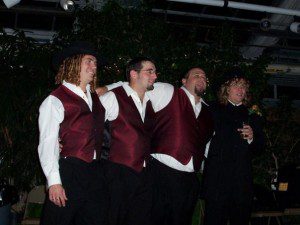
This particular version of the ring exchange is really heteronormative, but was what I used in my sister-in-law’s ceremony. If you are officiating a wedding you should address each member of the couple in whatever manner they prefer. There are also some couples who like to be presented after a wedding ceremony “Mr. and Mrs. Doug Hopkins” (or whatever). I don’t like doing that because I despise the idea that a woman should be known by her husband’s name. (If anything at my house we are Mrs. and Mr. Ari Mankey.)
Officiant: “There is no greater symbol of the love shared between two people than the ring. Circular, it has no beginning and no end, much like the love between two people being wed. (Groom’s name) do you take this woman to be your wife, to love her in sickness and in health, for richer or for poorer, for as long as your love shall last (or for as long as you both shall live)?”
Groom: “I do.”
(Groom places ring on the bride’s finger.)
Officiant: “(Bride’s Name) do you take this man to be your husband, to love him in sickness and in health, for richer or for poorer, for as long as your love shall last (or for as long as you both shall live)?”
Bride: “I do.”
(Bride places ring on groom’s finger.)
Officiant: “I now pronounce you husband and wife, you may kiss the bride!”
Before getting to the kissing part I’ll often give the happy couple a blessing. One of my favorites is often called the Navajo or Apache Blessing, but actually only dates from 1950 where it shows up in the book Blood Brother by Elliot Arnold.
Officiant: “Now you will feel no rain, for each of you will be the shelter for each other.
Now you will feel no cold, for each of you will be the warmth for the other.
Now you are two persons, but there is only one life before.
Go now to your dwelling place to enter into the days of your life together.
And may your days be good and long upon the earth.”
May your handfasting/wedding ceremony go off without a hitch, and may it be as special and as meaningful as my own was.
*I have run into a lot of officiants over the years who have forgotten this part. If you are presiding over a wedding your job is to be loud, not screw up any names, and communicate clearly. That doesn’t mean the ceremony is about you, because it’s not. Attention should always be focused on the happy couple.
Help me out! Like Patheos Pagan on Facebook!
 CLICK HERE TO “LIKE” PATHEOS PAGAN ON FACEBOOK
CLICK HERE TO “LIKE” PATHEOS PAGAN ON FACEBOOK
It’s easy to do, like Patheos Pagan and Raise the Horns on Facebook!


